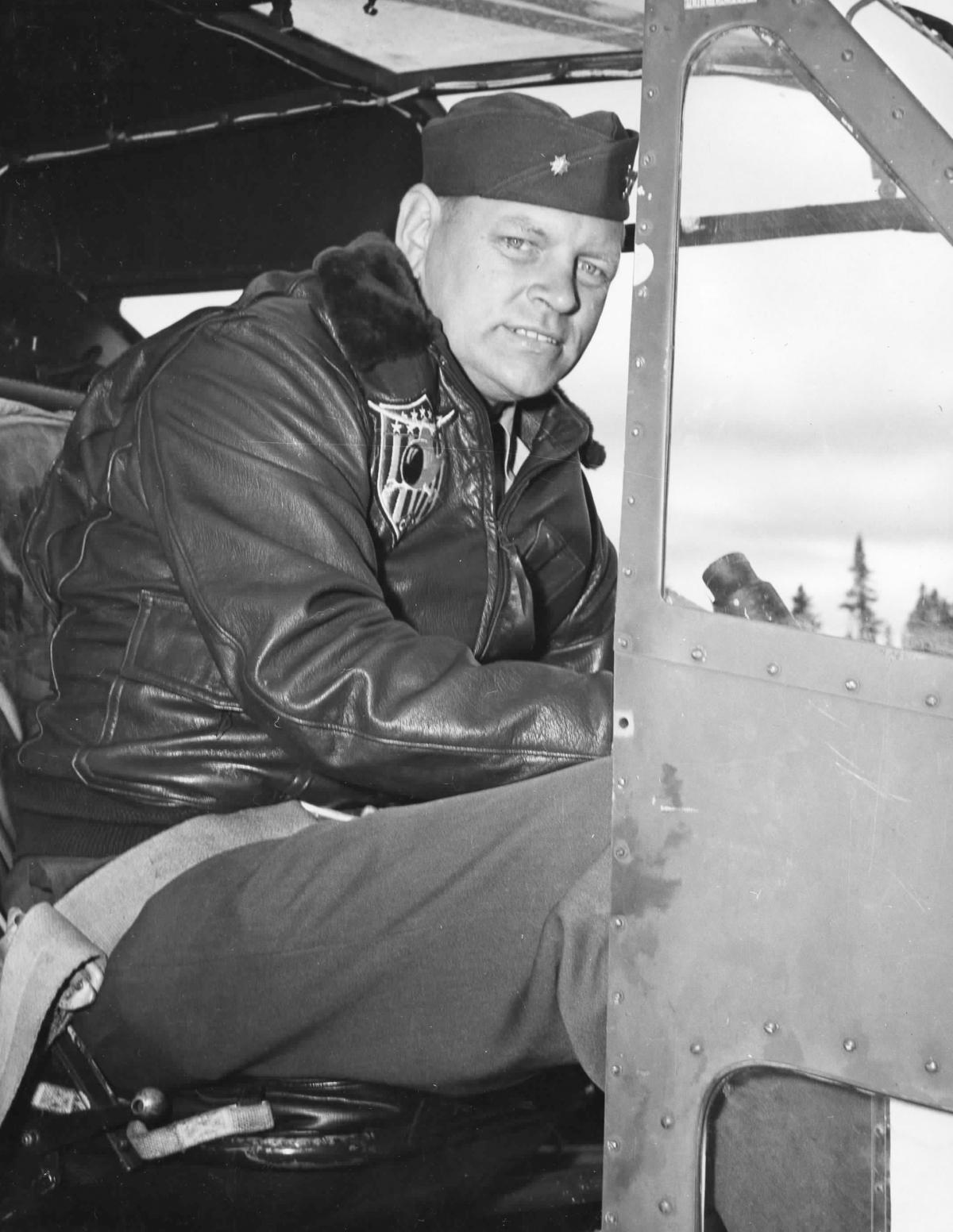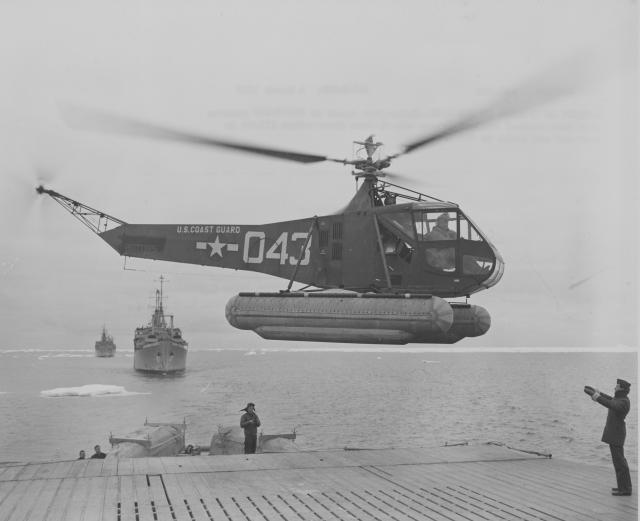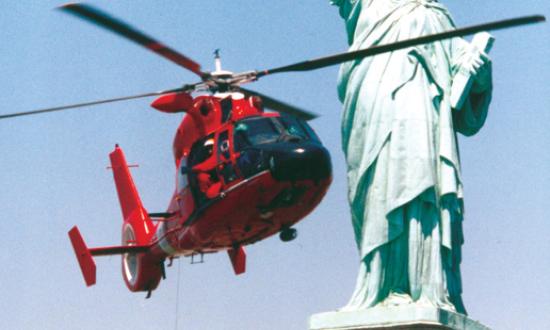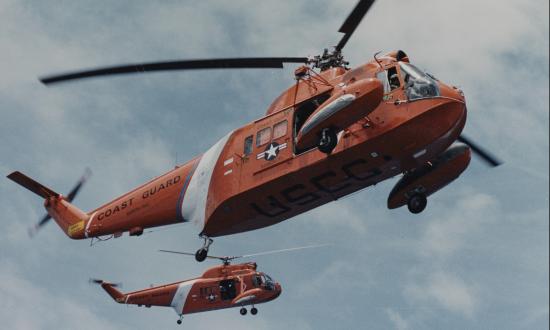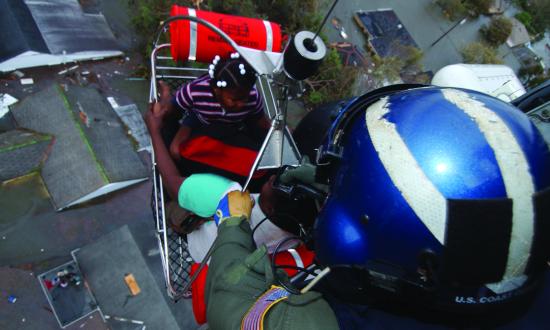On 15 February 1943, Chief of Naval Operations Admiral Ernest J. King—having quickly determined that rotary-wing aircraft's unique capabilities would increase World War II maritime security—assigned sea-going development of the helicopter to the U.S. Coast Guard. Naval aviation’s first designated helicopter pilot, Coast Guard Lieutenant Commander Frank Erickson, tested and accepted the first such aircraft in the Navy inventory, an HNS-1, at Bridgeport, Connecticut, on 16 October 1943. Erickson had brought along his trusted lead mechanic, Aviation Machinist’s Mate Oliver Perry, to inspect the helicopter and sit in the copilot’s seat during the one-hour test flight.
This proved to be the beginning of a continuing journey featuring man’s ingenuity, skill, and daring, as industry and technology constantly improved rotary-wing aircraft.
According to Sergei Sikorsky, son of trailblazing aircraft designer Igor Sikorsky: “There is no doubt in my mind that the Coast Guard pioneered the use of the helicopter as a rescue vehicle. It was under the leadership of two brilliant men, Commander Frank Erickson and Lieutenant Stewart Graham, that the rescue hoist and the Erickson basket were developed in 1944–46, in some cases with me as the simulated person in distress. The Coast Guard has proven time and time again Igor Sikorsky’s prediction that the helicopter will prove to be a unique instrument for the saving of human lives.”
Sikorsky Aircraft Corporation now proudly states that more than two million lives have been saved by its helicopters. In addition, dozens of other such aircraft have been used around the world to increase that total to well over three million people.
Delivering the Plasma
Commander Erickson conducted the first life-saving mission made in a military helicopter. On 3 January 1944, the USS Turner (DD-648) exploded while anchored off Sandy Hook, New Jersey. The destroyer was at anchor when the explosion occurred, and dozens of sailors were injured. Large quantities of plasma were urgently needed at local hospitals to ensure the success of the surgeries required to save the sailors’ lives.
A major snowstorm had closed all airports in the New York and New Jersey area, thus grounding all fixed-wing aircraft. Winds exceeded 30 knots, and ceilings were below 200 feet with snow squalls and heavy turbulence. The Third Naval District commander called Erickson and asked if his new helicopters were capable of flying from Naval Air Station Floyd Bennett Field in Brooklyn to lower Manhattan, where they would pick up the plasma and deliver it to Sandy Hook. Erickson said he could do the job, even though he had never flown a helicopter in such conditions. The maximum cruise speed of the HNS-1 helicopter he flew was only 70 knots. Nothing was on board the helicopter to allow instrument flight rules (IFR) conditions.
|
HNS-1 Hoverfly |
|
|
Manufacturer |
Sikorsky Aircraft |
|
Fuselage |
Metal and fabric |
|
Max. gross weight |
2,600 pounds |
|
Range |
120 miles |
|
Engine |
One R-550-3 200-HP piston |
|
Max. Speed |
70 knots |
|
Crew |
2 |
After taking off, Erickson flew at extremely low levels along the shoreline around Brooklyn and then across the East River to the Battery in lower Manhattan, where the plasma was located. Winds were gusting over 40 knots, and the water was choppy and freezing cold. He landed on a small empty lot at the tip of Manhattan and asked Aviation Machinist’s Mate First Class Gus Jablonski to exit the aircraft so they could strap two cases of plasma to the landing floats.
Erickson then backed his helicopter out of the small landing area and skimmed the waves across the Hudson River to deliver his life-saving cargo. A New York Times editorial later praised Erickson and Igor Sikorsky, emphasizing that “Nothing can dim the future of a machine which can take in stride weather conditions such as those which prevailed in New York on Monday.”
Rescuing the Survivors
The helicopter's first international life-saving mission of civilians captured a great deal of media attention around the world. On 18 September 1946, a Belgian Sabena Airways four-engine DC-4 aircraft crossed the Atlantic with 44 people on board. They had been scheduled to land and refuel at Gander Airport in northeastern Newfoundland. Air traffic control lost radio contact with the aircraft and, after determining that it had not landed safely, notified U.S. Coast Guard Operations in Argentia, Newfoundland. The Coast Guard launched several PBYs and PB-1Gs to search for the missing aircraft.
An inbound TWA flight located its crash site about 24 miles southwest of Gander and determined that at least some of the passengers had survived. The area was heavily wooded, and the ground proved to be a very large quagmire. A rescue team was formed, headed by U.S. Army Medical Corps Captain Samuel Martin, and flown by PBY "flying boats" to a nearby lake. The team then trekked more than a mile and a half through the swampy bog to reach the crash site, where they found 21 survivors alive but badly injured. Martin determined they could not be transported overland to the lake.
Coast Guard personnel were asked if their helicopters could be “shipped” to Newfoundland to transport the injured. Commander Erickson and other fledgling helicopter pilots and mechanics disassembled one HNS-1 at Coast Guard Air Station (CGAS) Elizabeth City, North Carolina, and one HOS-1 helicopter at CGAS Brooklyn and loaded them on board two U.S. Army Air Forces C-54 aircraft. They were flown to Gander, where a group of highly skilled enlisted mechanics quickly reassembled and flight-tested them in less than 48 hours.
|
HOS-1 Hoverfly-1 |
|
|
Manufacturer |
Sikorsky Aircraft |
|
Fuselage |
All metal |
|
Max. gross weight |
2,700 pounds |
|
Range |
120 miles |
|
Engine |
Franklin O-405-9 245-HP reciprocating |
|
Max. Speed |
75 knots |
|
Crew |
3 |
Meanwhile, the two PBYs dropped more supplies—including tents ,medical supplies, and lumber—at both the crash site and Gander Lake. The lumber was used to build platforms for tents and for the helicopters to land on to prevent them from sinking into the bog.
Over the next few days, pilots Erickson, Lieutenant Stewart Graham, Lieutenant Walter Bolton, and Lieutenant August Kleisch rescued the 18 survivors by making repeated flights, carrying out one survivor at a time, between the crash-site and Wolfe Lake. There, they were loaded into life rafts and towed to the PBYs for transport to Gander.



